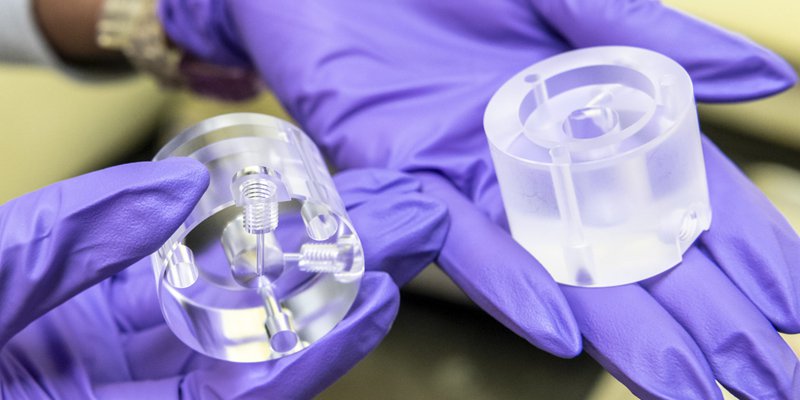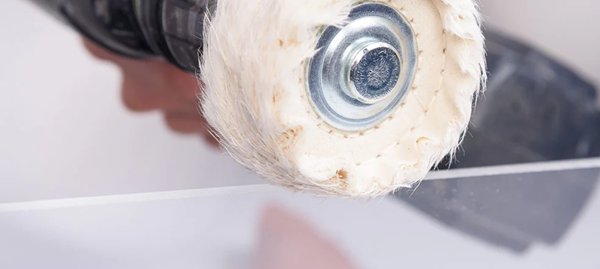- May 26, 2023
Polycarbonate is a common plastic material extensively utilized across numerous industries. Its versatile applications span from automotive components and optical lenses to medical devices. However, to use it for these purposes, polycarbonate needs to undergo a thorough polishing process that enhances its aesthetics and ensures optical clarity.
In this article, we will explore the basics of polycarbonate, its benefits, and various polishing techniques to help you make informed decisions about your polycarbonate projects.
Basics of Polycarbonate (PC)
Polycarbonate is an engineering plastic that boasts a unique combination of mechanical and optical properties. It has a tensile strength ranging from 55 to 75 MPa and a flexural strength of about 90 MPa.
Furthermore, its impact strength is remarkably high, reaching up to 850 J/m when measured using the Izod impact test. This impact resistance is approximately 250 times greater than that of regular glass.
In terms of optical properties, polycarbonate is known for its outstanding transparency, which rivals that of glass. Due to its exceptional properties, it is used in applications where strength and visibility are required, such as glazing, LED light diffusers, eyewear, compact discs, electrical components, and automotive parts.
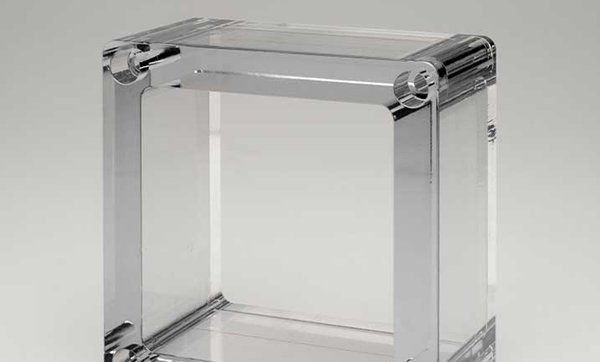
Benefits of Polished Polycarbonate
Polishing polycarbonate not only enhances its appearance but also improves its performance. A well-polished polycarbonate surface offers the following benefits:
Enhanced Clarity and Light Transmission
A polished and transparent surface allows more light to pass through, making it ideal for applications that require high transparency, such as lenses and light diffusers.
Improved Scratch Resistance and Durability
Polishing can create a smoother surface, and make it less prone to scratches and wear. This leads to a longer lifespan for the material and thus reduces maintenance costs.
Better Resistance to Chemicals and Environmental Degradation
Polishing can also shield the surface of the polycarbonate from harsh chemicals and environmental factors, improving its resistance to discoloration and degradation over time.
Increased Aesthetic Appeal
When the polycarbonate surface gets polished, it becomes more visually appealing. This is quite useful for consumer products and applications where appearance matters.
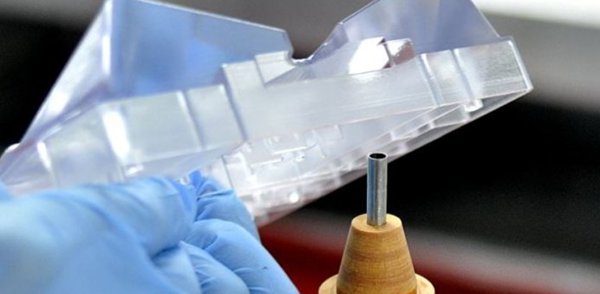
How to Polish Polycarbonate: Techniques and Steps
There are multiple techniques for polishing polycarbonate out there. From sanding and vapor polishing to buffing and flame polishing.
We’ll explore the fundamentals of each technique, its advantages and disadvantages.
1. Sanding
Sanding is a common surface finish-technique to remove scratches and make the surface smooth. It is one of the widely-used techniques for polishing polycarbonate.
In this process, an abrasive material is used to remove imperfections and create a smooth surface. The process starts with coarse grit sandpaper (200), followed by progressively finer grits (800 or more) to achieve the desired finish.
Sanding can be wet or dry. The dry sanding can heat the surface and make it gum. So, for the best results, wet sanding is recommended, as it helps to reduce heat buildup and prevent surface damage.
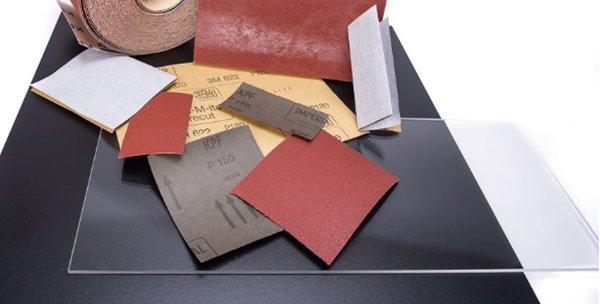
How Polycarbonate Sanding is Done? Stepwise Procedure
The results of the sanding operation depend on the skill of the worker and the technique followed to complete the process. Here’s one tested technique to attain the best finish:
- Step 1: Gather multiple grades of sandpaper (e.g., 200, 400, and 600 grit), water, wiping cloth, gloves, apron, and goggles.
- Step 2: Prepare the polycarbonate workpiece by slightly wetting it, but avoid excessive water usage.
- Step 3: Sand the surface progressively. Start with the lowest grit sandpaper, rub in circles to remove prominent scratches, and focus on accuracy while avoiding rushing the process.
- Step 4: Mist the surface with water to prevent debris buildup and keep the sandpaper lubricated.
- Step 5: Keep sanding until the surface is clean and smooth.
- Step 6: Progress from coarser to finer grit sandpapers for a smoother finish, and change the sanding technique from heavy pressure to lighter pressure as you proceed.
Advantages of Sanding Polycarbonate
- Inexpensive and straightforward method.
- Suitable for small or large surfaces.
- Can remove deep scratches and surface imperfections.
Disadvantages of Sanding Polycarbonate
- Labor-intensive and time-consuming.
- Can cause surface damage if not done correctly.
- Requires expertise for achieving a consistent finish.
- Doesn’t produce a very smooth and clear finish
2. Vapor Polishing
Vapor polishing is a chemical process that uses solvent vapors to dissolve the surface of the polycarbonate, resulting in a smooth, glossy finish.
The part is exposed to the vapor for a short period, causing the surface to melt and even out. The common solvents used in vapor polishing for polycarbonate is WELDON-4 (methyl acetate, methylene chloride, and methyl methacrylate monomer).
Moreover, as vapor polishing produces a fine and glossy finish, it is widely used in applications where high transparency is required, for instance, in optical lenses.
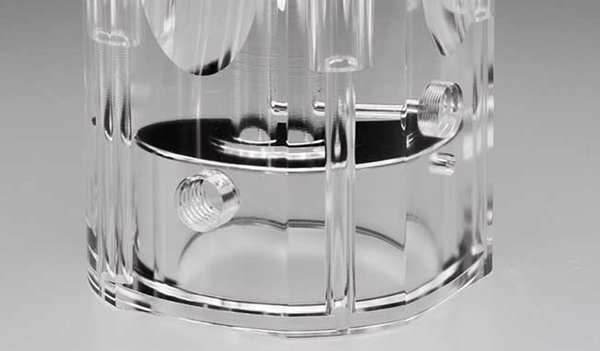
Vapor Polishing Polycarbonate: A Step-Wise Procedure
- Gather all required items. You will need a chemical solvent (e.g., Weld-ON 4), heating equipment (e.g., kettle), respirator or mask, and gloves.
- Prepare the polycarbonate surface for polishing by cleaning it.
- Heat the chemical solvent in a kettle until boiling point.
- Gradually apply the heated solvent vapor onto the polycarbonate surface.
- Observe the surface becoming clearer, smoother, and glossier as the vapor melts the polycarbonate.
Advantages of Vapor Polishing Polycarbonate
- Produces a high-gloss, mirror-like finish.
- Faster than manual sanding and buffing.
Does not introduce new scratches or surface imperfections.
Disadvantages of Vapor Polishing Polycarbonate
- Requires specialized equipment and handling.
- Solvent fumes are toxic; the process needs to be done in a highly-controlled environment.
- Expensive compared to other polishing techniques.
3. Buffing
Buffing is a mechanical polishing technique that uses abrasive compounds and a rotating buffing wheel to create a smooth, glossy surface. This process is usually used in conjunction with sanding, to achieve a high-gloss finish of the polycarbonate sheet.
Like sanding, buffing also involves the use of polishing compounds with varying levels of abrasiveness, starting with a coarser compound and finishing with a finer one for a mirror-like finish.
How Buffing of PolyCarbonate is Done?
Step 1: For the buffing operation, you” ll need these tools:
- Buffer
- Loose abrasive
- Protective clothing (e.g., gloves, goggles)
- Fine grit sandpaper
Step 2: Before initiating, sand the polycarbonate workpiece surface to remove deep scratches.
Step 3: Apply loose abrasive to the buffing machine, then buff the polycarbonate sheet, avoid holding the workpiece in one place, as this may damage the mop.
Step 4: Maintain a firm grip on the buffer. Before switching the machine on, hold it firmly to ensure your safety and carry out the buffing process effectively.
Advantages of Buffing PolyCarbonate
- Can produce a high-gloss finish.
- Removes fine scratches and imperfections.
- Creates an even, smooth finish.
- Cheaper and inexpensive.
Disadvantages of Buffing PolyCarbonate
- Messy process.
- Cannot repair deeply affected polycarbonate pieces.
- Can introduce new scratches if not done correctly.
4. Chemical Polishing
Chemical polishing involves immersing the polycarbonate part in a chemical solution that dissolves the surface, smoothing out any imperfections.
This method is effective for complex geometries and hard-to-reach areas. The solution typically contains a mixture of acids, solvents, and other chemicals that selectively dissolve the material’s surface. The common chemical polish usually used is methylene chloride.
How Chemical Polishing of Polycarbonate is Done?
- For the process, you will need a chemical polish (mainly methylene chloride), sandpaper, and protective clothing.
- Prepare the workpiece by sanding its surface to remove any apparent scratches. Then, wipe it clean using a wet cloth to remove debris.
- Apply the chemical polish and allow time for passivation to occur. It will smoothen the surface and polish it while dissolving the upper layer of the polycarbonate material.
- After the chemical polish has cured, run the surface under water to prevent cracking due to post-polishing stress.
Advantages of Chemical Polishing
- Can achieve a high-gloss finish.
- Suitable for complex geometries.
- Very less labor intensive.
Disadvantages of Chemical Polishing
- Requires specialized equipment and handling.
- Expensive compared to other processes.
- Highly-toxic chemicals are used during the process.
- May destroy the piece if not done correctly.
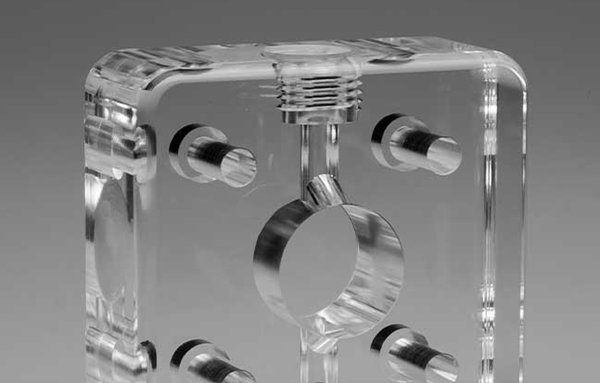
Polished Polycarbonate: Maintenance and Care
Routine Cleaning
Regular cleaning is essential for maintaining the appearance and performance of polished polycarbonate.
Use a soft cloth with a mild soap solution to gently clean the surface. Then, rinse it with water and dry it with a clean, lint-free cloth.
Avoid using abrasive cleaners or solvents that can damage the surface.
It’s also a good idea to clean the material periodically with a specialized plastic cleaner to maintain its clarity and shine.
Preventing Scratches and Damage
To prevent scratches and damage to the polished polycarbonate surface, always handle it with care.
Store polycarbonate parts with protective coverings, and avoid placing them on rough or abrasive surfaces.
When cleaning, use only non-abrasive cloths and gentle cleaning agents.
Consider using protective films or coatings to add an extra layer of protection against scratches and damage.
Long-term Care for a Polished Finish
Polycarbonate is susceptible to yellowing and degradation over time due to exposure to UV radiation and environmental factors.
Consider applying a UV-resistant coating or opting for a UV-stabilized polycarbonate material.
Regularly inspect your polycarbonate parts for signs of wear, discoloration, or damage. and address any issues promptly to maintain their appearance.
Get Polishing Services for Your Plastic Parts at WayKen
If you’re looking for professional polishing services for your polycarbonate parts, Choose WayKen is the perfect solution.
With extensive experience in plastic machining and surface treatment, WayKen offers a wide range of polishing techniques tailored to your needs. You can trust our experts to deliver top-notch results for your plastic parts, from automotive components to medical devices and consumer products.
Conclusion
By polishing polycarbonate, manufacturers can significantly enhance its appearance and longevity. This guide has explored various methods, including buffing, sanding, and chemical polishing. By understanding the specific requirements of each technique and following the outlined procedures, you can successfully achieve a smooth, polished finish on your polycarbonate surfaces.
FAQs
Which plastic can be vapor polished?
Vapor polishing can be used on various types of plastics, including polycarbonate, acrylic, (PMMA), ABS, and polysulfone (PSU).
What should you not use on polycarbonate?
Don’t use ammonia-based cleaners, acetone, and alcohol-based products on polycarbonate as they can cause chemical degradation or discoloration of the material.
What does UV do to polycarbonate?
Prolonged exposure to ultraviolet (UV) radiation can have adverse effects on polycarbonate. It may cause yellowing, loss of transparency, and a reduction in mechanical properties.

